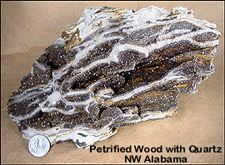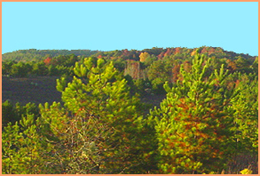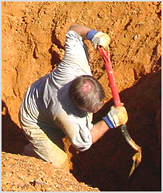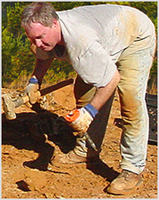Jeff Deere and I spent an unseasonably warm day last week collecting petrified wood in Northwest Alabama. But, before I get to the brief story, let me offer the following background information.
Fantastic petrified wood can be collected along a wide swath from northwest to southeast Alabama, including Marion, Macon, Barbour, Elmore and Bibb Counties. Perhaps the most striking aspect of this wood is that it is often covered with a druse of clear to smoky quartz. Area residents have long referred to this material as "diamond rock". This ancient wood is known to occur in the Cretaceous Coker Formation that is a member of the Tuscaloosa Group, comprised primarily of very fine to medium sand with some silt and clay
 layers along with intermittent gravel, chert and, of course, petrified wood. The Coker may represent a near shore fluvial environment that was part of a deltaic system.
layers along with intermittent gravel, chert and, of course, petrified wood. The Coker may represent a near shore fluvial environment that was part of a deltaic system.
Petrified wood is a fossil formed by the infiltration of minerals into cavities between and within cells of natural wood, usually by silica (silicon dioxide, SiO2) or calcite (calcium carbonate, CaCO3). The petrifaction process occurs well beneath the earth's surface where wood has become buried under sediment. This replacement of organic tissue by mineral deposits can be so precise that the internal structures as well as the external shape of the wood can be perfectly preserved.
In the case of what would become northwestern Alabama petrified wood, ancient streams traveling through a swampy delta environment deposited the wood, sediment and debris. In order for the wood to not have a chance to decay before petrification, it must have been quickly buried to anaerobic conditions; this may have occurred during or just prior to a major depositional event such as a big flood. It is not known when the quartz crystallized but its appearance suggests multiple events. There must have also been some sort of radiation source to produce the smoky quartz. Very large logs have reportedly been recovered in Alabama, such as the 32-feet long nearly-complete monster that was unearthed July 2006 in Barbour County by a couple Panama City rockhounds.
Jeff and I made our way last Thursday to northwest Alabama
 to collect . . . well you guessed it, petrified wood. To keep a promise, all I can tell you about the location is that it is somewhere in Marion County and is not to be confused with the well-known petrified wood area at Brilliant. As I wrote in the first paragraph of this report, petrified wood can be found in a relatively wide area and we just happened to stumble into some information that we couldn't resist checking out for ourselves. The picture to the right ought to give you an idea of how deep in the boonies we ended up!
to collect . . . well you guessed it, petrified wood. To keep a promise, all I can tell you about the location is that it is somewhere in Marion County and is not to be confused with the well-known petrified wood area at Brilliant. As I wrote in the first paragraph of this report, petrified wood can be found in a relatively wide area and we just happened to stumble into some information that we couldn't resist checking out for ourselves. The picture to the right ought to give you an idea of how deep in the boonies we ended up!

A 6-1/2 hour drive necessitated that I head out the day before and spend the night in a local motel. Jeff decided to get up early to make his 4-hour drive, so that he met me mid-morning at the site. By the time that Jeff arrived, I had put a major dent in the relatively soft but heavy ground. But, I had only recovered a few minor keepers and was eager to find more.

By late morning, we started to locate some large log sections, but they were tough to extract being buried deeply in very hard dirt. As is often the case in the area, many of the logs were surrounded by thick plates of very hard limonite. I haven't yet determined the geologic story
behind the limonite, but it certainly made the digging and recovery much more
 difficult. With great effort, we liberated numerous large petrified wood chunks up to about 2 feet wide by 3 feet long.
difficult. With great effort, we liberated numerous large petrified wood chunks up to about 2 feet wide by 3 feet long.
Most of the quartz crystals are contained in pockets and voids within the wood, so each large block that we heaved out of the hole had to be carefully cobbed to reveal surfaces that sparkled like black diamonds in the bright Alabama sun. By late afternoon, we were so satisfied with our take that we quit digging and divided the spoils before heading back into town to eat and recover before driving home the next day. I was pretty sure that Jeff was pleased with his share, unless he was faking big time when I took the last picture of him.
The following images are of a few representative specimens after spending some quality time in front of a power washer at home.